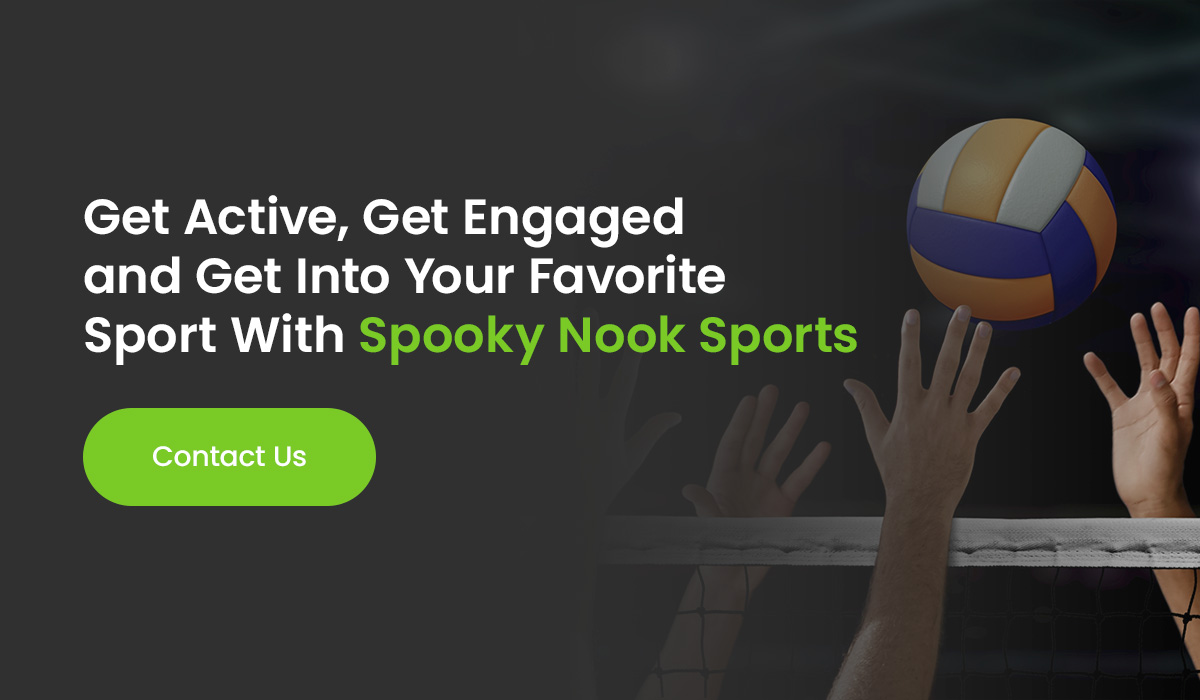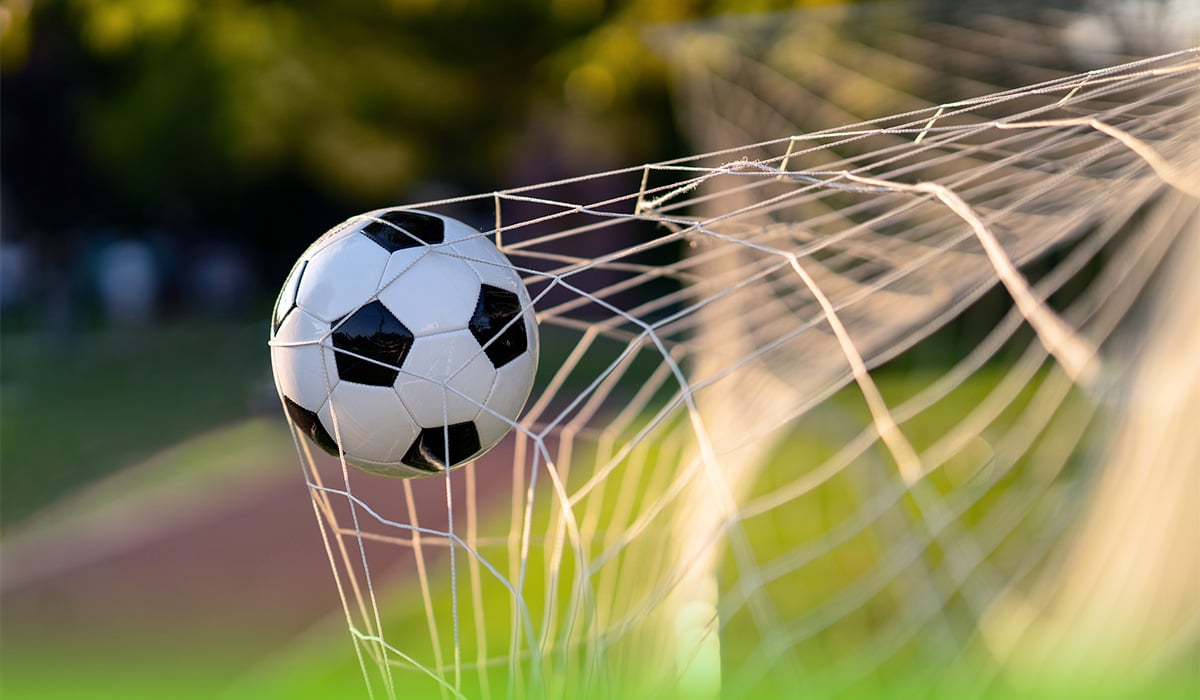
Subscribe to the Blog
Stay up to date
Getting into a new sport of learning how to master the ones you love means having the right equipment to get the most out of the sport and your practice sessions.
This list of equipment is not required when playing at Spooky Nooks Sports but is our recommendation for the best way to get involved in your favorite sports, improve your game and find an exciting new hobby to invest in.
Soccer
Soccer is one of the world's most popular sports. The rules are simple, many people can play at once, and you can play it anywhere from an indoor facility to your own backyard. Your required equipment list can vary depending on how you want to play and the setting.
Here is a general list of the things you need for soccer practice and games:
- Portable goal: Portable goals let you play soccer anywhere. Coming in various sizes, you can buy smaller goals for younger players and better portability. For a local club, a large full-sized goal is the best bet, but smaller, more convenient goals will work well for practicing.
- Soccer ball: This is the most essential piece of soccer equipment. The pitch and goals can be improvised, but the ball is the entire game. A well-inflated soccer ball is easier to kick and aim with than an over of an under-inflated ball. The ideal pressure for a soccer ball is 8.5 to 15.6 pounds per square inch.
- The right-sized soccer ball: Having a soccer ball of the right size is essential for proper training and matches. The size of the ball is determined by age, and there are five ball sizes. Size three balls are best suited for kids between the ages of 5 and 8, size four is for children between 8 and 12 and size five, the biggest size, is for adults and professionals.
- Poles and cones: Training cones help you plan practice routines and obstacles to improve your skills. For example, speed and agility practice involves dribbling the ball in and around the cones. Cones can also be used to map out a goal. Poles and cones work together to plan training or playing areas.
- Shin guards: There are three types of shin guards in soccer. Ankle shin guards are most suitable for young and intermediate players. They are secured with cloth stirrup under the foot and an elastic strap across the top of the calf. The cloth provides ankle protection when kicking. Shin socks have built-in guards and are popular with kids because they're easy to put on. Slip-in shin guards slide into your soccer sock. Professionals and advanced players typically use them.
- Cleats: Soccer cleats are flexible and lightweight. They're designed to help players run comfortably, achieve the right grip, perform tricks and kick the ball while providing traction. There are no toe studs on soccer cleats to prevent players from sliding and colliding with each other and for other safety reasons.
Baseball and Softball
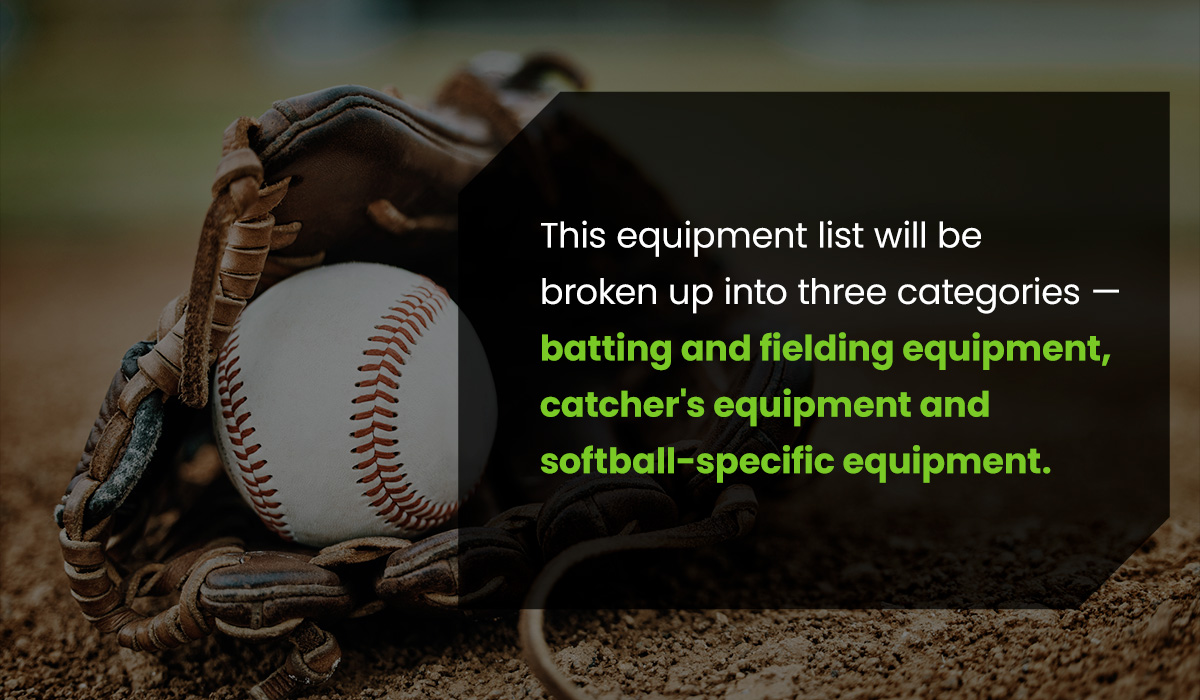 Baseball is a game with multiple different positions, each requiring slightly different equipment to serve each role. Softball and baseball are played on the same type of field, but there are some important differences between the games. Softball players throw underhand, while overhand is used in baseball. There are two styles of playing softball, slowpitch and fastpitch, while there is only one style in baseball. Baseballs are smaller than softball balls, and softball bats have longer barrels than baseball bats.
Baseball is a game with multiple different positions, each requiring slightly different equipment to serve each role. Softball and baseball are played on the same type of field, but there are some important differences between the games. Softball players throw underhand, while overhand is used in baseball. There are two styles of playing softball, slowpitch and fastpitch, while there is only one style in baseball. Baseballs are smaller than softball balls, and softball bats have longer barrels than baseball bats.
This equipment list will be broken up into three categories — batting and fielding equipment, catcher's equipment and softball-specific equipment.
Batting and fielding equipment is used by the batter at the pitch, and the fielders play defense and prevent runs:
- Baseball bat: Baseball bats come in various sizes, grips and materials, each with their own advantages. To find a bat of the right length, stand with your arms extended horizontally. The best bat size for you is the one that measures from the center of your chest to the tips of your fingers. Metal alloy bats offer great swing weight, wood bats are ideal for training your hitting skills and composite bats are most popular with advanced players.
- Batting helmet: Batting helmets protect your head from fastballs and stray bat swings. These helmets are designed to withstand any risks and hazards the wearer might encounter on the baseball pitch. A properly fitting helmet will not obscure your vision and will stay in place while running.
- Baseball glove: Baseball gloves are known as fielding gloves or mitts. The large open-hand design of the glove makes it easier to catch baseballs without hurting your hand and lowers the risk of the ball bouncing out of your palm. Finding the right baseball glove size depends on your age and position.
In baseball, the catcher's position is to catch the balls missed by the batter. The catcher requires a lot more padding, protection and gear to keep them safe from the ball and bats:
- Catcher's helmet: This headgear offers more protection than baseball helmets and batting helmets. The main difference is the addition of a face cage for enhanced protection. Being in a more vulnerable place, the catcher needs more protection.
- Chest protector: Padded chest equipment is equipped to the catcher's torso to protect the upper body.
- Knee guards: Catchers kneel in place to catch stray balls. Knee guards make kneeling more comfortable while protecting the legs. They are an extra padded layer of foam added to the top of the leg protector.
Choosing the right softball equipment is similar to finding the right baseball equipment:
- Softball glove: Softball glove sizes work the exact same as baseball glove sizes. Children under 7 need gloves ranging from 8 to 11 inches, depending on their position, but catchers need gloves between 29.5 and 30 inches. Older children need gloves from 10 to 12.75 inches, while catchers need 30 to 32.5 inches. Players 14 and older generally need gloves ranging from 11.5 to 13 inches, and catchers need gloves from 32 to 34.5 inches.
- Softball bats: Finding the best fastpitch softball bats involves the exact same method used to find the ideal baseball bat length. When looking for the right slowpitch bat, consider the length, width, weight distribution and bat materials. You also need to consider what type of hitter you are. Lighter bats let you swing faster and hit line drives. All softball bats are 34 inches long with different weights depending on the player's size.
Basketball
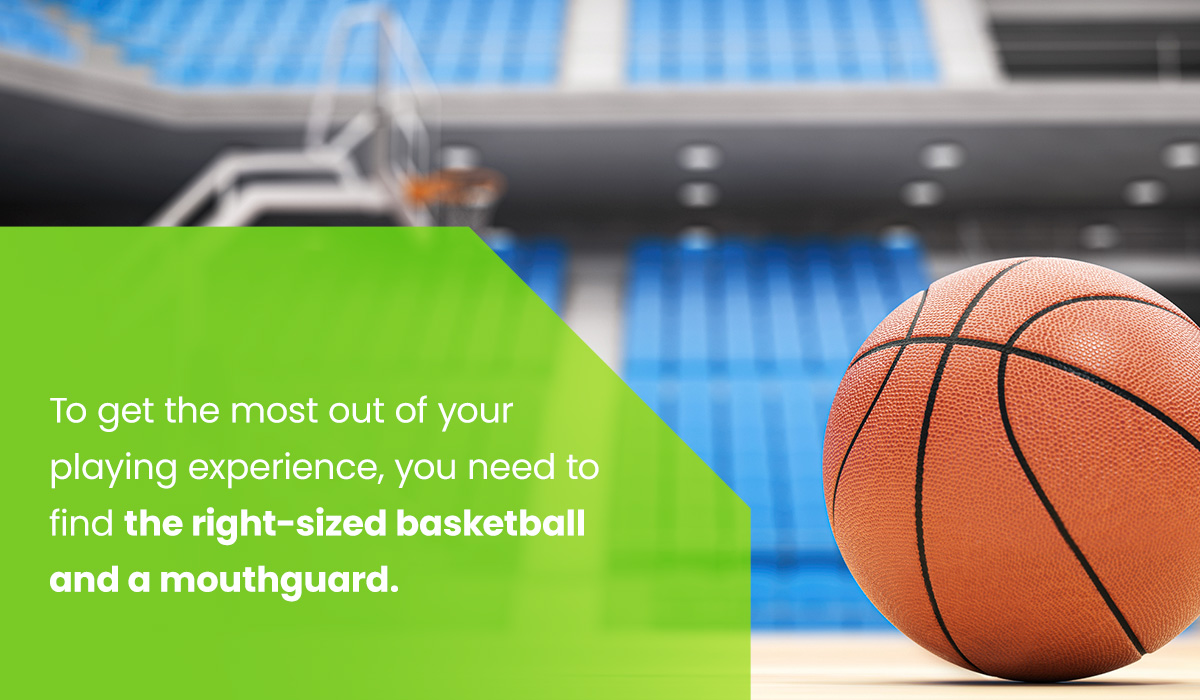 Basketball is a fun game that requires very little equipment to play. All you really need is a basketball and a hoop, and off you go. To get the most out of your playing experience, you need to find the right-sized basketball and a mouthguard:
Basketball is a fun game that requires very little equipment to play. All you really need is a basketball and a hoop, and off you go. To get the most out of your playing experience, you need to find the right-sized basketball and a mouthguard:
- Ball: Size five basketballs are best suited for players 8 or younger. Size six balls are ideal for female players above the age of 9 and male players between the ages of 9 and 11. Size seven balls are the largest, with a circumference of 29.5 inches, and a weight of 22 ounces. They are designed for male players older than 12.
- Mouthguard: Mouthguards in basketball are worn on the top teeth. There are three types of basketball mouthguards. Boil-and-bite mouthguards fit using thermoplastic material that is pliable when heated in water. Stock mouthguards are available in per-formed sizes, and finding a comfortable fit can be tricky. Custom-made mouthguards give you the best protection and fit and are made by your dentist or orthodontist. Comfort and protection are the key factors when choosing the right guard.
- Hoop and backboard: Make sure you choose a hoop that includes a backboard, which is an essential component of many basketball maneuvers and scoring.
Volleyball
Volleyball is another great sport that requires very little to enjoy. All you need is a volleyball and two poles to hold up your net:
- Ball: Your choice of volleyball should be determined by your skill level, how you want to play and your age. Size four balls are used for players 13 years or younger. Size five balls are the standard size for all ages and official competitions.
- Net: The volleyball net sizes for men's and women's games are slightly different. Men's games require a net that is about 8 feet high, while women's and co-ed games require a net about 7 feet and 4 inches tall. Beach volleyball needs a roughly 30-foot net, while indoor volleyball nets are shorter.
- Kneepads: Many players find well-fit kneepads helpful for sliding and diving for the ball. Choose a pair that fit securely to the knee and leg and offers enough comfortable padding to hit the playing surface with force.
Lacrosse
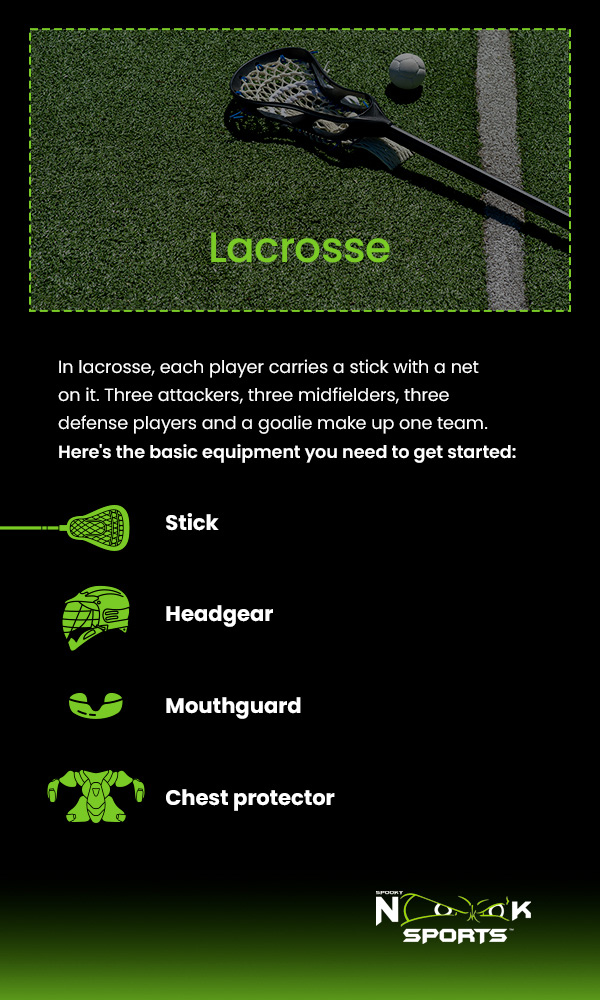 In lacrosse, each player carries a stick with a net on it. Three attackers, three midfielders, three defense players and a goalie make up one team. Here's the basic equipment you need to get started:
In lacrosse, each player carries a stick with a net on it. Three attackers, three midfielders, three defense players and a goalie make up one team. Here's the basic equipment you need to get started:
- Stick: There are three parts to a lacrosse stick — the head, shaft and mesh. Tighter heads are good for offensive play, while wider face shapes are good for defense. The mesh or pocket, is traditionally a six to nine-diamond mesh, with diamond referring to the number of holes in the mesh. The mesh is up to the player and has no effect on offensive or defensive play.
- Headgear: A lacrosse helmet needs to fit snugly and not move when you shake your head. Your eyes must look through the top bars, and the chin straps must fit tightly and be even in length on either side of your face.
- Mouthguard: Mouthguards must fit the upper jaw, and goalies must also wear them. While required for younger players, it is highly recommended that more advanced and older players find comfortable mouthguards that fit in their mouths properly without moving. They are designed to protect your teeth and other facial bones.
- Chest protector: Goalies must wear a chest protector to stay safe during the game. The right protector will include padding that covers your shoulders, collarbone and sternum.
Field Hockey
Hockey is a great team game that builds friendships, teaches teamwork skills and is a great workout and hobby. This is a list of equipment needed to play field hockey and engage in this fun indoor and outdoor sport:
- Stick: There are two different types of hockey sticks — ones for offensive and defensive players. It's best to have more than one sick made of durable material. Ideal sticks are made of laminate wood and carbon fiber composite because they are durable and effective.
- Hockey bag: A hockey bag will keep all the balls and sticks together while protecting them simultaneously. There can be a lot of equipment to carry to hockey practice and games, so investing in a hockey bag is always a good idea.
- Gloves: While gloves are required for ice hockey, they are optional for field hockey players. They are recommended because they will help you make more powerful shots with your stick and protect your wrists and hands.
- Mouthguard: Your mouthguard protects your mouth and teeth from damage in this physical contact sport. A comfortable mouthguard can make all the difference to your safety while playing hockey. Make sure it fits comfortably in your mouth and isn't loose.
- Hockey socks and shin guards: Hockey socks are long to keep shin guards in place.
- Hockey shell: Hockey shells are lightweight nylon outer-layer shorts that fit over pants. They keep your clothes safe from being torn, match your team colors and are comfortable and loose-fitting.
- Elbow pads: The additional padding and cushioning provided by your elbow pads will keep your joints safe. They also prevent you from accidentally harming other players with your elbows while running, holding your stick or swinging.
- Helmet: There are a lot of accidents that can happen during a hockey game. A hockey helmet keeps your head safe while not inhibiting your ability to play the game, look around and focus on the game without worrying about your head.
At Spooky Nook Sports, we provide the fitness and training facilities you need to learn new skills, improve your game and get active in the right environment. Our personal trainers and fitness center will help you hone your sports skills. We also offer sports performance training and senior programs that let everyone and anyone practice the sports they love.
Spooky Nook Sports also offers a Sport Sample Card. This lets you buy a pass for your child that grants access to one session of a camp or clinic for up to six different sports. Your child can find the sport they love without paying for an entire camp. We've introduced the Sport Sample Card as a great way to help younger kids or those new to athletics find the sports they might like and experiment with different activities.
Find out more about how we can inspire you to work out and build your skills at our facilities. Gain access to the workout and training you've been looking for in Manheim, Pennsylvania. You can also contact us any time to ask questions, learn more and book any of our services.